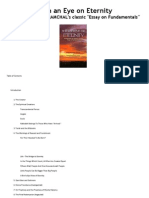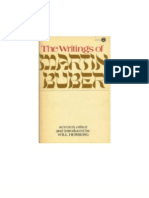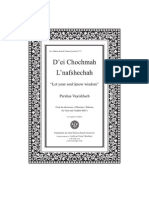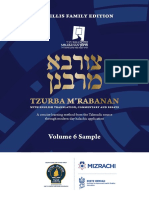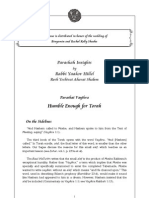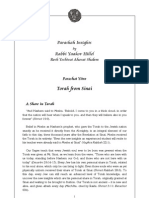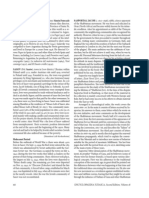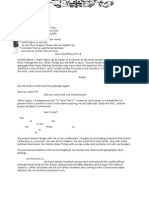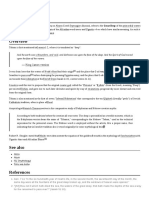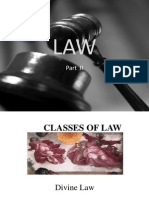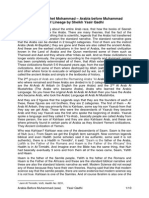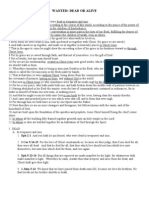Parshas Bo 5773
Parshas Bo 5773
Uploaded by
Harav Michael ElkohenCopyright:
Available Formats
Parshas Bo 5773
Parshas Bo 5773
Uploaded by
Harav Michael ElkohenOriginal Description:
Copyright
Available Formats
Share this document
Did you find this document useful?
Is this content inappropriate?
Copyright:
Available Formats
Parshas Bo 5773
Parshas Bo 5773
Uploaded by
Harav Michael ElkohenCopyright:
Available Formats
Dei Chochmah LNafshechah
Parshas Bo
Shalosh Seudos1 of Parshas Bo 5767
" ' -, - : - - , - , ". ,
And Hashem said unto Moshe: Go in unto Pharaoh, for I have hardened his heart, and the heart of his servants, that I might show these My signs in the midst of them.2
Watering the Trees of the Pardes The Rishonim discuss that although Moshe and Aharon told Pharaoh that a plague of locusts would descend on Egypt, they did not warn him about it as they had for the other plagues. All they said was: " - - " If you refuse to send my people, behold I will bring locusts tomorrow within your borders.3 It is well known that the strength of Egypt was in their firstborn sons, as we find in the verse: "" To Him that struck Egypt in their firstborn, for His kindness endures forever.4 The moment any Jew stands at the gateway to a fresh start in avodahto truly pray and learn with his entire beingthe yetzer hara immediately arrives on the scene and works to weaken his resolve so that he despairs of ever completing his divine service. We know very well that the ultimate redemption depends on the Torah, which has four major layers which are well known: pshat, the simple level; remez, the level of allusion; drush, the level of homiletic
1 2
The lesson was delivered at the third meal of Shabbos. Shemos 10:1 3 Ibid., 10:4 4 Tehillim 136:10 3
Dei Chochmah LNafshechah
Parshas Bo
interpretation; and sod, the esoteric meaning. [These four are often expressed by the acronym ,or Pardes.] The Emek Hamelech writes that there is a less known fifth level: the razin drazin, the most secret and innermost level. This hidden level of deep secrets has only begun to be revealed. The redemption is mostly dependent on the revelation of this area of Torah.5 The main objective of the yetzer hara is to weaken Torah study, especially at the crucial level of razin drazin. This is the deeper meaning of the third story of Rebbe Nachman where the sage commands his children that even though they can also do other work, their main work should be to water the trees. This means that although one must learn all four elements of Pardeswhich are the source of everythinghis main object should be to water the trees with the water of the supernal life-giving stream of razin drazin. Through this holy influx, everyone will be inspired to genuinely return to Hashem. The Power of the Firstborn When the yetzer hara tries to weaken ones resolve to attain the light of Torah, one must remind himself how many times Hashem has strengthened him and aided him to attain what he had thought was spiritually impossible in the past. This recall of past spiritual support is an aspect of the holy bechor, the firstborn. He must remember the many times that Hashem has helped him out of difficult straits in the past. He should also understand that he was not worthy even to learn the little Torah that he knows. It was only Hashems boundless kindness that enabled him until now, so why shouldnt he turn to Him now as well? If we would only recall all the kindnesses bestowed upon us by Hashem when we asked His help in the past, we would surely remember our Creator. The Ramban explains that this concept is expressed in the Name with which Hashem revealed Himself to the Jewish people through Moshe on the eve of their redemption. " -
Emek Hamelech 5:72 4
Dei Chochmah LNafshechah
Parshas Bo
" -And should they say to me, what is His Name? Moshe Rabbeinu was told to provide them with the Name Eheyeh Asher Eheyeh, I will be as I will be. The Ramban teaches that this Name was meant to convey a lesson: They have no need to know My Name since I will be with them throughout all their difficulties This is the greatest proof that there is a G-d: that He is close to us whenever we call.6 Although Pharaoh, the bechor dklippah, or the aspect of firstborn in the realm of impurity, works to obscure ones vision of past kindnesses, one must fight against him. We see with our own eyes that Hashem has been with us until now and we must believe that He will help us attain the highest and most hidden levels of Torah. Just as He has helped us in the past, He will not abandon us in the future. As the verse states: I am Hashem, I have not changed.7 One must be ever vigilant to combat this force of the firstborn of unholiness associated with Pharaoh, because one who is even slightly in its grasp will be unable to draw close to Hashem. He will be filled with self-doubt and fear that Hashem will not listen to his prayers. We must smite the firstborn of unholiness through deep contemplation of all the kindnesses that Hashem has done for us. In this manner, the holy aspect of firstborn, the every firstborn that is sanctified to Me, becomes dominant, since one finally understands that every spiritual step forward was hardly the natural result of ones efforts. He will enter into the light of Eheyeh Asher Eheyeh and understand that Hashem was with him whenever he called, and will surely listen to every future petition and help abundantly. The Plague of Locusts With this introduction we can grasp why Hashem did not warn about arbeh in the same way that He warned of the coming of the other plagues. Arbeh was one of the final three plagues that correspond to the upper three sefiros of the mentalities regarding which the verse states, "" ' - And Hashem will
6 7
See the Rambans commentary to Shemos 3:13. Malachi 3:6 5
Dei Chochmah LNafshechah
Parshas Bo
plague Egypt, plaguing and healing.8 The same plagues that harmed Egypt cured us by enabling us to cleave to the light of Hashem. When a person wishes to draw near to Hashem in Torah and dveikus in an aspect of mochin dgadlus, with fully developed and expanded holy awareness, he feels as though heaven itself is showing him that he will never achieve anything. Its as if he is being told, like Moshe, "" - Go unto Pharaohbut with no clear instructions what to do when he gets there. The Zohar teaches that Moshe was frightened of the great snake of unholiness, and our inner snake likewise works to bring us to feelings of despair and weakness by bringing up our hidden fears and telling us we will never get there. But the difference between the state of unholiness represented by chometz and the condition of holiness referred to as matzah is represented by only a little open space, as mentioned in the holy Zohar. [In Hebrew, the words and are spelled the same with one exception: matzah has a hei while chometz has a cheis. The difference between the letter and the letter is that in a cheis the space on the left top is closed, while in a hei the space is open.] The holy Arizal explains that this space is an aspect of the verse, " - " If a corpse [chalal literally means a space] should be found slain in the land...9 In terms of avodah this indicates that one who wishes to spiritually imbibe matzahwhich the holy Zohar calls food of faithand come to dveikus with mochin dgadlus must be an aspect of a corpse: he must work himself to the death, as it were. This is the meaning of our sages words, Torah is only acquired by one who kills himself over it. This means that one cannot grasp [the depth of] Torah if things go smoothly for him. One who thinks that he will have great success in Torah and is not confronted with many obstacles cannot truly attain his goals. On the contrary, one for whom everything goes smoothly is actually cast away. No tzaddik ever came to the light of Torah through immediate success. They were all forced to sacrifice themselves like
8 9
Yeshayah 19:22 Devarim 21:1 6
Dei Chochmah LNafshechah
Parshas Bo
Rav Elazar ben Horkynos who worked himself so hard that he had a foul odor emanating from his mouth, as we find in the Midrash. This foul odor represents Pharaoh, which in Hebrew has the same letters as evil mouth. [ ]= This aspect of being a corpse refers to a feeling of absolute powerlessness to attain Torah, especially the most lofty and hidden Torah of Atikah Sesimaah. One who feels this with deep conviction must be willing to serve Hashem even without seeing success or experiencing spiritual illuminations. He must come to a place where he no longer cares if he merits mastery of Torah. Instead, he is willing to exist in the state of corpselike powerlessness of Pharaoh / peh rah. If he merits to serve Hashem despite such feelings of helplessness he eventually will attain Torah. This is indicated in the words of our sages on the verse: "" Those who blacken themselves (through hard labor) for My sake will find Me.10 One who blackens himself like a raven for the Torahs sake will merit to grasp it. But first one must be willing to lose both worlds and face the wrath of Pharaoh. Removing the Chometz When one tries to attain closeness to Hashem, he immediately must contend with chometz and seor (leaven), which represent various kinds of illicit thoughts that try to catch him in their net. But one must fulfill the verse, - , - " " -- - No chometz shall be seen, and no seor shall be seen, within all your borders.11 Our sages teach, You may not see your own, but you may see the chometz of others and of hekdesh, of property that has been consecrated away from personal use.12 One must remove from his mind all illicit thoughts of the klippah. Even if any extraneous thoughts do enter ones mind, he should fulfill the dictum of our sages, you may see the chometz of another and of hekdesh. This indicates that one should fight with the forces of negativity and overcome these thoughts in Hashems honor.
10 11
Mishlei 8:17 Shemos 13:7 12 Pesachim 5b 7
Dei Chochmah LNafshechah
Parshas Bo
As the Baal HaTanya taught: One who has not yet achieved the level of tzaddik and must struggle with the klippos certainly has pain from falling into thoughts that are not Hashems will. But the very fact that he continues to struggle even after falling generates a great feeling of pleasure for Hashem, as it were. Even a tzaddik who is already an aspect of matzah since he is free from such thoughts, generates less pleasure for Hashem in a certain aspect than a simple person faithfully working to expel foreign thoughts from his mind. Every person can rid himself of such thoughts by contemplating Hashems Divine Names. This brings great purity and is very efficacious in the war to overcome forbidden thoughts. This practice brings a person to the level of the true tzaddikim who are spared such evil thoughts for the most part. The Baal Shem Tov revealed, however, that sometimes illicit thoughts enter a tzaddiks mind to enable him to rectify other souls. The instant a tzaddik is confronted with such a thought he immediately elevates it by completely rectifying it. Even a simple person must act like a tzaddik in this matter and rectify any illicit thought he may have, especially those that arise during prayer. This is the deeper meaning of the different mystical meditations for the three prayers of each day. The Arizal explains that every prayer brings about new spiritual clarifications and lifts up different holy sparks from their entrapment in the klippos. [When a person realizes that illicit thoughts are merely a revelation of a stray spark that must be lifted up to its source and actively reconnects to Hashem as a result of such thoughts, he is performing the clarification of that prayer.] One elevates such thoughts through deep contemplation of Divine Names. In light of this, even one who has not yet completely purified his thoughts should not feel pained or discouraged as a result of his struggles. Quite the contrary; he is bringing pleasure to his Creator [by continuing to struggle]. The truth is that the main spiritual element of chometz is despair. Despair is active within those people who start to believe that only the tzaddikim in earlier generations could merit the light of Torah,
Dei Chochmah LNafshechah
Parshas Bo
especially the Torah of Atikah Sesimaah. We must not give in to such insidious thoughts. Instead, we must arouse within ourselves holy chutzpah. We must recall that our sages taught that we are the most brazen of nations,13 and we should recall that Hashem invested within each of us a very holy soul. On the contrary, the closer we get to the times of Moshiach, the easier it is for us to reveal the hidden and lofty Torah of Atikah Sesimaah which will bring the redemption. Fighting the Force of Amalek Even if one feels that he does not now how to proceed, this is precisely the way to acquire Torah and come to an expanded level of holy awareness. One must first enter the aspect of Pharaoh / peh ra and be willing to truly sacrifice everything to acquire the Torah. As we find in words of the Pri Haaretz: Why should a person say that there is another way to attain closeness to Hashem besides the path of mesiras nefesh, of selfsacrifice? Hashem wants each of us to attain the soul-level of yechidah, which can only be realized by one who is filled with self-sacrifice for Hashem. It says clearly that we are to love Hashem. One who truly loves with all his soul can think of nothing besides the object of his affection. One must work to come to a level of complete unity with Hashem and think of nothing else. He should be willing to forgo everything to merit true dveikus in Hashem and the Torah. We must come to this level practically by making a cheshbon hanefesh, by taking a moral inventory each day of how much of our physical desires we are willing to give up to be whole with Hashem. Although the yetzer hara comes and tries to entice a person to at least focus on less essential elements instead of going to the heart of the matter and working on the physicality that keeps him distant from the Creator, we must remain strong. It is this strategy that is alluded to in the words of the verse, " - " And [Amalek] struck at the hindmost of you, all that were enfeebled at your rear...14 The Midrash explains that Amalek would cut off the milah of their victims and throw them
13 14
Beitzah 25 Devarim 25:18 9
Dei Chochmah LNafshechah
Parshas Bo
up toward the heavens. [The hint is in the word vayezanev, which alludes to the fact that they tailed their victims.] This signifies that Amalek worked to wean away the weaker Jewish souls from thinking about areas of holiness or restraint in fulfilling their physical appetites. Amalek tries to block us most especially in the area of personal purity. Sadly, the force of Amalek makes one feel an aspect of spiritual death, which makes him afraid, just as Moshe feared the snake of unholines. But we must recall all the good Hashem has done for us and believe that He will surely do us many more kindnesses and help us through all spiritual challenges. The Four Levels of Mochin and the Four Worlds The Arizal explains that the plague of locusts corresponds to the 52-Name, darkness to the 45-Name, the plague of the first born to the 63-Name, and the splitting of the sea of reeds corresponds to the 72-Name. [These represent four ways to articulate Hashems Name HaVaYaH. - --has a numerical value of 52. ---has a numerical value of 45. ---has a numerical value of 63, and ---has a numerical value of 72.] These four miracles represent a revelation of the four worlds and the four aspects of mochin. These are what is known as G-ds Throne of Glory and the experience of the Divine presence to which each person must ascend. The Zohar writes that Abba / Chochmah is the foundation of his daughter, Malchus.15 This means that the letter yud of each level is revealed mostly through the lowermost hei of each level. The Tal Oros explains that the highest level is always revealed in the fourth level below it, which is an element of Malchus. Hashem in His mercy shined into the later generations three very high souls, each of whom revealed a different dimension of Torah and each of whom represented a different letter of the Divine Name. First was the Arizal. The Torah he revealed represents the yud of the Divine Name HaVaYaH and symbolizes Chochmah. Then came the Baal Shem Tov. The Torah of chassidus is symbolized by the first hei and
15
Zohar III:258a 10
Dei Chochmah LNafshechah
Parshas Bo
represents Binah. The final soul that has already been revealed is Rebbe Nachman of Breslov. His Torah is symbolized by the vav of the Name HaVaYaH. The new Torah of Atikah Sesimaah will be completely revealed by Moshiach himself, as the holy Zohar writes. This lofty and hidden Torah is symbolized by the final hei of Hashems Name and reveals a completely different dimension within the Arizals Torah of Chochmah. Every day a new facet of Torah is revealed which is similar to the Torah that will be revealed in the future. The Torah that will be revealed in the future will draw down a very great expansion of Daas which is expressed in the vision of, the wolf living with the lamb.16 This Daas will be a complete merging of the chassadim, symbolized by Atzilus, and the gevuros, which symbolize the three lower worlds of Beriyah, Yetzirah, and Asiyah. This is discussed by the Baal HaTanya when he explains the meaning of the Divine Name TzevakosHosts. Through this Name, the lower three worlds of Beriyah, Yetzirah, and Asiyah are connected with the higher world of Atzilus. One must search very assiduously to access this Name. Even if one is very learned but is in an aspect of hester panim, he is living in the shadow of Hashems presence rather than in its revealed light, he has not yet attained the path to connect Beriyah, Yetzirah, and Asiyah to Atzilus. This is the purpose of all of creation: to make a dwelling place in the lower worlds for Hashem. It is easy to understand, then, why the Name Tzevakos symbolizes an aspect of birth, since it is through this joining of the upper and lower worlds that G-dliness is revealed to everyone. Through the Torah of the unique tzaddikim of all the generations, the light of Elokus is revealed and Hashem will return to Tzion in the full view of all the nations. Even in this physical world, the greatness of Torah will be revealed. We will finally see the greatness of Esther, and that her seven handmaidens [which represent the seven wisdoms] are not the purpose of creation at all, since they merely serve her.
16
See Likutei Moharan 13 11
Dei Chochmah LNafshechah
Parshas Bo
The Torah as a Gift But everything depends on our avodah. We must focus on the essentials like the ultimate redemption, as we pray about in the blessings " " and " " .No Jew should ever forget the coming redemption. We should just have the strength to resist the yetzer of Amalek that tells us that we are not worthy. Instead, we should fling ourselves into the sea of self-sacrifice, especially since we are so close to the big day of redemption. We must rely on Hahsems kindness and mercy just like our teacher Moshe did. Hashem should help us for His Names sake, to truly believe and rely on Him with complete faith. We must recall that He split the sea with the 72-Name. The Hebrew word for kindness, " ,"also has a numerical value of 72. We can only enable ourselves to leap into the sea of self-sacrifice by remembering Hashems past kindness and knowing with certainty that He will help us further. In truth, the entire Torah is above nature and must be given to us from on high. As the Vilna Gaon learns from the words of our sages, One who says, I have toiled and I have found, it to be believed. The reason why it says found and not attained is because even after all our efforts, Torah must be given as a giftit always remains a metziyah. Let Your Soul Know Wisdom This is the meaning of: "" Let your soul (nefesh) know (dei) wisdom (Chochmah) and it will be a crown (Kesser) for your head.17 Daas depends on memory, as the Baal HaTanya writes. The main element of memory must be rooted in the aspect of Chochmah, as the verse states, "" The beginning of [or it can be read, is] wisdom.18 This beginning or first aspect of Chochmah is the holy firstborn, the ability to remember the history of Hashems kindness at all times. We must remember that every bit of Torah or genuine spiritual
17 18
From the Shabbos zemer Dror Yikrah, based on Mishlei 24:14. Tehillim 111:10 12
Dei Chochmah LNafshechah
Parshas Bo
elevation that Hashem has graced us with has been beyond natural. This is letting ones soul know wisdom, since one must shine in this aspect when ones nefesh is aroused. The nefesh is the repository of ones yearning. When filled with a great desire to draw nearer to the King, one must listen to the aspect of holy bechor within himself. This voice tells him to keep striving and never to give up. He must be resolved to persevere even if he feels great darkness or even a bitter taste of spiritual death in his mouth. Although he must also work on other aspects of avodah he should never forget the bechor dkedushah, he must remember where he really is and yearn to go ever higher. He must be vigilant never to be like those who sin and then learn some gemara or do another spiritual act and think this guilt offering has atoned. We must always search for the absolute truth and regret what we do wrong. One who learns Torah must search for the deep inner meaning of what he studies and draw nearer to holiness through the Torah. If he is like Nachshon ben Aminadav who threw himself into the sea, his selfsacrifice will make him worthy of revealing a crown to his head, the light of the element of yechidah within him. Although one must always be involved in learning, he must also be occupied with the 72-Name by remembering Hashems kindness and being absolutely willing to sacrifice himself at all times for closeness to Hashem. He will then, guard Your holy mitzvos, observe Your holy Shabbos by entering into the deep pleasure of absolute connection to the light of Shabbos. This imparts a deep satisfaction in the absolute connection to Hashems ultimate reality. The Hidden Festival of Tu BShevat This self-sacrifice is associated with Tu BShevat, a very deep and hidden festival. This holiday is only really revealed to those who never lose sight of the tree, in the sense of always drawing down an awareness of Hashems transcendence into his worldly existence. The numerical value of the word ilan / tree is the same as the combination of HaVaYaH and ADNI. [91 = 26 + 65] It was for this reason that Rav Chaim Vital was so precious in the eyes of heaven, even though he lived in a generation
13
Dei Chochmah LNafshechah
Parshas Bo
of many great scholars. Because he demonstrated an unprecedented willingness to abandon all other interests in the world and focus only on his objective of obtaining closeness to Hashem and absorbing the light of His Torah, he was valued far above others. This is why the festival is called, Rosh Hashanah of the Tree, rather than the trees, because true love only focuses on a single object, in this case the supernal tree that embodies the joining of HaVaYaH and ADNIand it is only such a focused love that can bear fruit. May Hashem awaken our hearts to pursue Him and Him alone; may we abandon our pursuits of worldly objectives and only long for the supernal tree, the yichud of the Holy One and His Shechinah. Then we will merit to taste of the rising sap that is drawn into the tree from the flowing brook, the wellspring of living waters, with the arrival of our righteous redeemer in mercy. Speedily and in our days, amen.
Translated and Adapted by Rav Micha Golshevsky.
14
You might also like
- Nefesh HaTzimtzum, Volume 1: Rabbi Chaim Volozhin’s Nefesh HaChaim with Translation and CommentaryFrom EverandNefesh HaTzimtzum, Volume 1: Rabbi Chaim Volozhin’s Nefesh HaChaim with Translation and CommentaryRating: 4.5 out of 5 stars4.5/5 (4)
- Lawrence Fine - The Contemplative Practice of Yihudim in Lurianic KabbalahDocument18 pagesLawrence Fine - The Contemplative Practice of Yihudim in Lurianic Kabbalahאליעזר באומגרטן100% (2)
- Shomer Emunim On TzimtzumDocument12 pagesShomer Emunim On TzimtzumHarav Michael ElkohenNo ratings yet
- Tikkuney HaShabbat - Final.1Document47 pagesTikkuney HaShabbat - Final.1Amanuel Ukbayohannes DestaNo ratings yet
- Parshas Tazria Metzora-EnglishDocument27 pagesParshas Tazria Metzora-EnglishHarav Michael Elkohen100% (1)
- Nefesh HaTzimtzum, Volume 2: Understanding Nefesh HaChaim through the Key Concept of Tzimtzum and Related WritingsFrom EverandNefesh HaTzimtzum, Volume 2: Understanding Nefesh HaChaim through the Key Concept of Tzimtzum and Related WritingsRating: 5 out of 5 stars5/5 (2)
- BodyDocument77 pagesBodyErikaNo ratings yet
- 2 Viduy Rav Pataya PDFDocument15 pages2 Viduy Rav Pataya PDFArturo MontielNo ratings yet
- 43 Arizal Parsha Devarim PDFDocument11 pages43 Arizal Parsha Devarim PDFSebastianPalenNo ratings yet
- Maamor Vayita Eishel - Vayeiroh 5747Document32 pagesMaamor Vayita Eishel - Vayeiroh 5747leahNo ratings yet
- RaMCHaL Essay - With An Eye On EternityDocument26 pagesRaMCHaL Essay - With An Eye On EternityDavidbenYosef100% (1)
- Prayer For Tikun HaYesodDocument9 pagesPrayer For Tikun HaYesodDavid Saportas LièvanoNo ratings yet
- Garments of Soul PDFDocument51 pagesGarments of Soul PDFAlber SánchezNo ratings yet
- 600,000 SoulsDocument15 pages600,000 SoulsYehoishophotOliver100% (1)
- Tefillin: Ewish RAPDocument12 pagesTefillin: Ewish RAPSudhit SethiNo ratings yet
- The Complete Jewish Study Bible: The Following Echart Is FromDocument7 pagesThe Complete Jewish Study Bible: The Following Echart Is Frombeach musician100% (1)
- The Writings of Martin BuberDocument347 pagesThe Writings of Martin Buberredencion2013100% (5)
- Trinity of The Seventh-Day Adventists and The Roman Catholic Churches ComparedDocument72 pagesTrinity of The Seventh-Day Adventists and The Roman Catholic Churches ComparedJeason Montera100% (3)
- Parshas Chayei SoraDocument27 pagesParshas Chayei SoraHarav Michael ElkohenNo ratings yet
- Parshas Vayikra-EnglishDocument28 pagesParshas Vayikra-EnglishHarav Michael Elkohen100% (1)
- Parshas Ki Tisa - EnglishDocument17 pagesParshas Ki Tisa - EnglishHarav Michael ElkohenNo ratings yet
- The Beginning of Wisdom 5782Document160 pagesThe Beginning of Wisdom 5782Ralph Arald Soldan100% (2)
- Parshas Vayeira English2013Document24 pagesParshas Vayeira English2013Harav Michael Elkohen100% (1)
- From the Guardian's Vineyard on Sefer B'Reshith : (The Book of Genesis)From EverandFrom the Guardian's Vineyard on Sefer B'Reshith : (The Book of Genesis)No ratings yet
- Speaking Torah Vol 2: Spiritual Teachings from around the Maggid's TableFrom EverandSpeaking Torah Vol 2: Spiritual Teachings from around the Maggid's TableNo ratings yet
- Walking As A Sacred Duty New VersionDocument29 pagesWalking As A Sacred Duty New VersionElliot WolfsonNo ratings yet
- Urim TumimDocument50 pagesUrim TumimPriscilajaege100% (1)
- English Siporay Masiyos New PDFDocument512 pagesEnglish Siporay Masiyos New PDFhaggen90tckhotmail.com100% (1)
- Jewish MeditationDocument24 pagesJewish Meditationjeryon91100% (1)
- Vayelek MoshehDocument176 pagesVayelek Moshehbookslibros2014100% (1)
- 53 Arizal Parsha VeZot Haberachah PDFDocument13 pages53 Arizal Parsha VeZot Haberachah PDFCesar Dos Anjos100% (1)
- Challah Recipe With Kabbalistic Meditations For ShabbatDocument2 pagesChallah Recipe With Kabbalistic Meditations For Shabbatseekhashem100% (2)
- Divrey Yaakov by Rabbi Yaakov AddesDocument576 pagesDivrey Yaakov by Rabbi Yaakov Addessage718100% (2)
- BGLG 74 20 Tetzaveh 5774Document36 pagesBGLG 74 20 Tetzaveh 5774api-245650987No ratings yet
- 05 Arizal Parshas Chayei SarahDocument24 pages05 Arizal Parshas Chayei SarahAdrian SaavedraNo ratings yet
- Introduction To Tikunei Zohar 1Document45 pagesIntroduction To Tikunei Zohar 1Amanuel Ukbayohannes Desta0% (1)
- Masekhet AzilutDocument3 pagesMasekhet AzilutSmere DadaNo ratings yet
- Mishkan Hashalom, Tabernacle of PeaceDocument36 pagesMishkan Hashalom, Tabernacle of PeaceAlan García-Ramos100% (1)
- BGLG 74 22 Vayakhel 5774Document40 pagesBGLG 74 22 Vayakhel 5774api-245650987No ratings yet
- Shomer HabrisDocument22 pagesShomer HabrisJesse GlaserNo ratings yet
- Parshas Vayishlach EnglishDocument14 pagesParshas Vayishlach EnglishHarav Michael ElkohenNo ratings yet
- Sefer Tikunim 1Document435 pagesSefer Tikunim 1David Saportas Lièvano100% (4)
- All Torah Light Spreads... Chaim Vital PDFDocument3 pagesAll Torah Light Spreads... Chaim Vital PDFDaville BulmerNo ratings yet
- A Brief Note On Pittum Ha-KetoretDocument17 pagesA Brief Note On Pittum Ha-KetoretDavid Saportas LièvanoNo ratings yet
- Jewish Sacred TextsDocument12 pagesJewish Sacred TextsZaab LonNo ratings yet
- Parshas Tetzave-EnglishDocument27 pagesParshas Tetzave-EnglishHarav Michael Elkohen100% (1)
- Shaar Hay I ChudDocument334 pagesShaar Hay I ChudJavier Ugaz100% (1)
- Parshas Mishpatim-EnglishDocument25 pagesParshas Mishpatim-EnglishHarav Michael ElkohenNo ratings yet
- 2my Prayer v2 PDFDocument205 pages2my Prayer v2 PDFAbraham Rasgado González100% (1)
- The Ellis Family Edition: Volume 6 SampleDocument10 pagesThe Ellis Family Edition: Volume 6 SampleSam MillunchickNo ratings yet
- Parshas B'Chukosai EnglishDocument25 pagesParshas B'Chukosai EnglishHarav Michael ElkohenNo ratings yet
- Tishrei Part One 5777 EnglDocument60 pagesTishrei Part One 5777 EnglanherusanNo ratings yet
- Parashá Jukat - Ariel Bar TzadokDocument4 pagesParashá Jukat - Ariel Bar TzadokryojananNo ratings yet
- Wings of The SunDocument511 pagesWings of The Sunpatobotero043No ratings yet
- The Tikunei Zohar of Rabbi Shimon Bar Yohai: Shiur 1Document7 pagesThe Tikunei Zohar of Rabbi Shimon Bar Yohai: Shiur 1Alexei Diaz-PazNo ratings yet
- Chessed LavrahamDocument76 pagesChessed LavrahamMacielkarug100% (2)
- Maamor - Issa Bemedrash - Chayei Soroh - 5748-1Document28 pagesMaamor - Issa Bemedrash - Chayei Soroh - 5748-1leahNo ratings yet
- Rabbi Jacob Ibn Chabib - Ein Jacob - Vol 2Document306 pagesRabbi Jacob Ibn Chabib - Ein Jacob - Vol 2Exequiel Medina100% (2)
- From The Wellsprings Shavuos 5783 1 0Document10 pagesFrom The Wellsprings Shavuos 5783 1 0Yehosef ShapiroNo ratings yet
- Rav Baruch Rosenblum - Bereshit 5783 - 5783Document6 pagesRav Baruch Rosenblum - Bereshit 5783 - 5783danielporpinoNo ratings yet
- Torah 101-Vayakhel Parsha I. Answers To Study Questions (Ki-Tissa)Document4 pagesTorah 101-Vayakhel Parsha I. Answers To Study Questions (Ki-Tissa)api-204785694No ratings yet
- Sodot HagilgulimDocument12 pagesSodot HagilgulimJuan MedelNo ratings yet
- Rav Yaakov Hillel On TzimtzumDocument10 pagesRav Yaakov Hillel On TzimtzumHarav Michael ElkohenNo ratings yet
- Living in Two WorldsDocument11 pagesLiving in Two WorldsHarav Michael Elkohen100% (3)
- Gra On TzimtzumDocument28 pagesGra On TzimtzumHarav Michael Elkohen100% (1)
- Parshas Vayeira English2013Document24 pagesParshas Vayeira English2013Harav Michael Elkohen100% (1)
- Introduction From Sulam HaAliyahDocument5 pagesIntroduction From Sulam HaAliyahHarav Michael ElkohenNo ratings yet
- The Heights of HesedDocument10 pagesThe Heights of HesedHarav Michael ElkohenNo ratings yet
- Turning Days Into DiamondsDocument7 pagesTurning Days Into DiamondsHarav Michael ElkohenNo ratings yet
- Parshas Tetzave-EnglishDocument27 pagesParshas Tetzave-EnglishHarav Michael Elkohen100% (1)
- Eating WarningsDocument10 pagesEating WarningsHarav Michael ElkohenNo ratings yet
- Parshas Terumah-EnglishDocument26 pagesParshas Terumah-EnglishHarav Michael ElkohenNo ratings yet
- Parashat VayikraDocument10 pagesParashat VayikraHarav Michael ElkohenNo ratings yet
- Torah From SinaiDocument13 pagesTorah From SinaiHarav Michael Elkohen100% (2)
- Parshas Mishpatim-EnglishDocument25 pagesParshas Mishpatim-EnglishHarav Michael ElkohenNo ratings yet
- Parshas Re'i EnglishDocument26 pagesParshas Re'i EnglishHarav Michael Elkohen100% (1)
- Parshas Ki Teitzei-EnglishDocument28 pagesParshas Ki Teitzei-EnglishHarav Michael ElkohenNo ratings yet
- Sasportas and Shabbtai TzviDocument22 pagesSasportas and Shabbtai TzviHarav Michael ElkohenNo ratings yet
- Parashat Ki TetzeDocument6 pagesParashat Ki TetzeHarav Michael ElkohenNo ratings yet
- The Heights of HesedDocument10 pagesThe Heights of HesedHarav Michael ElkohenNo ratings yet
- Good Friday Ecumenical Sermon 2012Document2 pagesGood Friday Ecumenical Sermon 2012api-106882544No ratings yet
- The GCT in ScriptureDocument5 pagesThe GCT in ScripturemarkspsNo ratings yet
- Dictionary of Deities and Demons in The BibleDocument2,046 pagesDictionary of Deities and Demons in The BibleNancy SuárezNo ratings yet
- 666 DecodedDocument13 pages666 Decodedpalharjeet0% (1)
- CSEC Religious Education June 2005 P2 Option ADocument6 pagesCSEC Religious Education June 2005 P2 Option Aamber100% (1)
- Michael Tsarion - Astrotheology - Part 1 PDFDocument44 pagesMichael Tsarion - Astrotheology - Part 1 PDFvotech100% (5)
- Reid NOV 2009 NewsletterDocument2 pagesReid NOV 2009 NewsletterReidMomNo ratings yet
- Pray Like ThisDocument2 pagesPray Like Thisapi-17579961No ratings yet
- Tell El-Amarna Tablets in The British MuseumDocument316 pagesTell El-Amarna Tablets in The British Museumyskndr100% (3)
- My Life Is Laced With MiraclesDocument152 pagesMy Life Is Laced With MiraclesamylohrmanNo ratings yet
- 11 - The Sin of Laziness - A Study On ProverbsDocument8 pages11 - The Sin of Laziness - A Study On ProverbsOluwakayode Olamoyegun100% (1)
- TehomDocument2 pagesTehomscribd.river89228No ratings yet
- Law Part 2Document16 pagesLaw Part 2Minerva Agrito LautrizoNo ratings yet
- The Seerah of Prophet Mohammad - Arabia Before Muhammad (Saw)Document10 pagesThe Seerah of Prophet Mohammad - Arabia Before Muhammad (Saw)FriedIqbalAtherNo ratings yet
- Topics On ChristologyDocument3 pagesTopics On ChristologyRamil Moreno SumangilNo ratings yet
- Hanukkah Hoax 2015Document1 pageHanukkah Hoax 2015Rogelio Martinez100% (1)
- The Three Holy Hierarchs and GeocentrismDocument5 pagesThe Three Holy Hierarchs and GeocentrismDan Constantin100% (2)
- Religious Education School Based AssessmentDocument9 pagesReligious Education School Based AssessmentShemar Blkhrtz Young100% (1)
- The Resurrection - SermonDocument4 pagesThe Resurrection - SermonChaleshi MabotweNo ratings yet
- Box & Spoon Box & Spoon 11: But... Everyone Else Is Doing It?!?!?!Document4 pagesBox & Spoon Box & Spoon 11: But... Everyone Else Is Doing It?!?!?!Holy Anargyroi Greek Orthodox Church100% (1)
- Pages From הסינונימיה בלשון המקרא על פי שיטת מלבי''םDocument11 pagesPages From הסינונימיה בלשון המקרא על פי שיטת מלבי''םtzchok@gmail.comNo ratings yet
- 2015 January Sacred LessonsDocument44 pages2015 January Sacred LessonsMarguerite PaizisNo ratings yet
- Royal Ambassadors II Corinthians 5Document4 pagesRoyal Ambassadors II Corinthians 5Gabriel Dinca100% (1)
- WANTED DEAD or ALIVE Sermon and Outline by Charles A. YawnDocument3 pagesWANTED DEAD or ALIVE Sermon and Outline by Charles A. YawnCharles A. YawnNo ratings yet
- Early Journal Content On JSTOR, Free To Anyone in The WorldDocument4 pagesEarly Journal Content On JSTOR, Free To Anyone in The Worldpishoi gergesNo ratings yet
- Jesusyouth Jesusyouth: International Newsletter International NewsletterDocument16 pagesJesusyouth Jesusyouth: International Newsletter International Newsletterjyjc_admNo ratings yet
- First Homily On The Annunciation To The Holy Virgin MaryDocument9 pagesFirst Homily On The Annunciation To The Holy Virgin MaryMelangell Shirley Roe-Stevens SmithNo ratings yet










